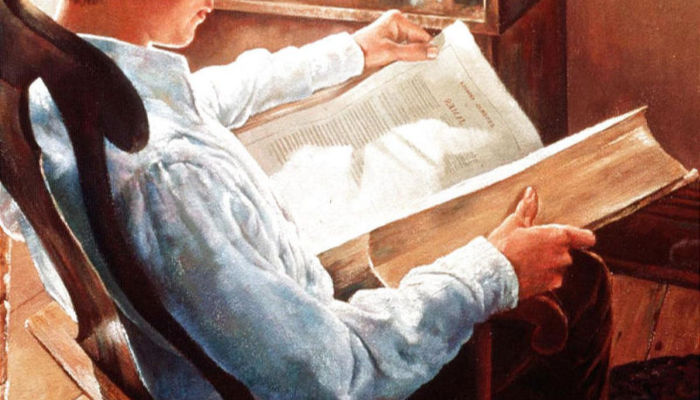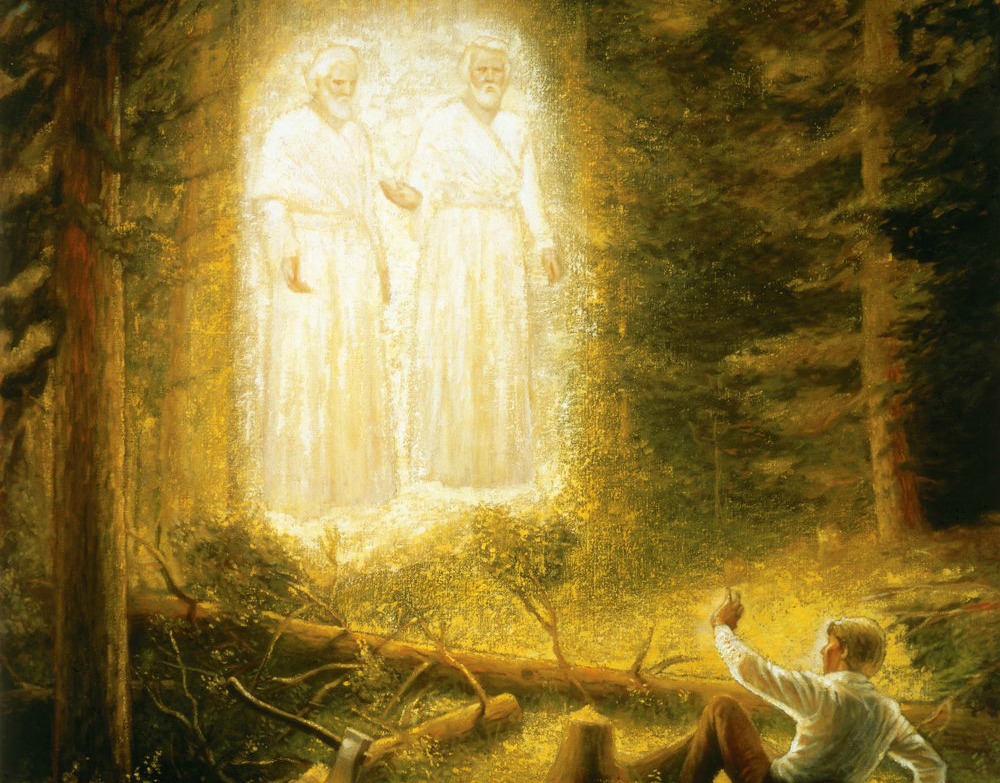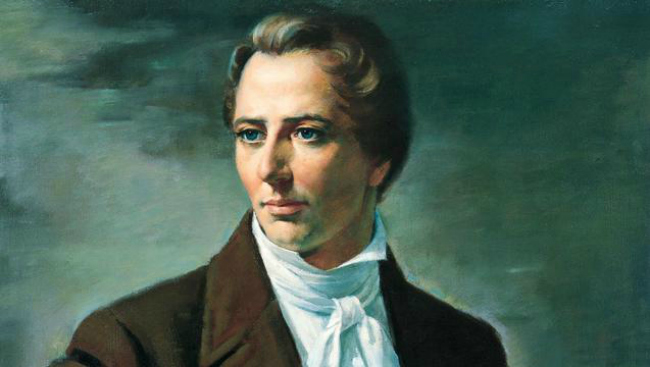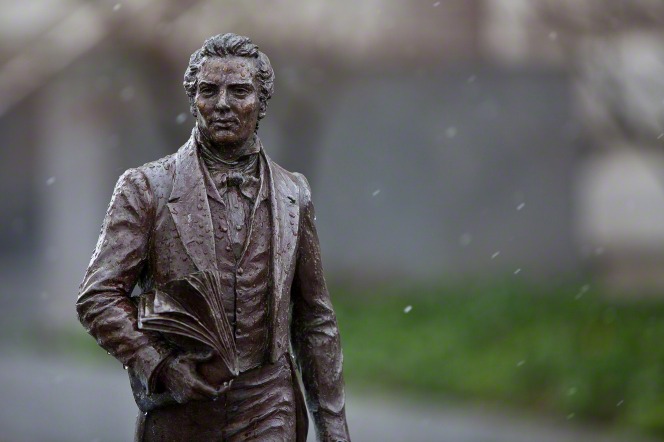Why Are There Differences Between Joseph Smith’s 4 First Vision Accounts?
The First Vision began the restoration of The Church of Jesus Christ of Latter-Day Saints. In the Sacred Grove, Joseph Smith, Jr. saw God and Jesus Christ at the age of 14 and received answers to his prayer. Joseph gave four accounts of his experience, each one unique. Why did he record multiple versions of the First Vision? Why are there differences between them? Do these differences suggest that Joseph fabricated the experience, or is there a more likely explanation? Let’s explore the history, similarities and differences of the accounts.
The Short Answer:
There are more similarities than differences between the four accounts of the First Vision. The main elements of the vision are still consistent throughout and the differences are minimal. Historians say that when stories are told over time and to different people in different circumstances, then there are bound to be some differences between them. Some aspects are focused on while others aren’t. In fact, the differences in the First Vision accounts actually help support that the vision did happen, because they show that Joseph did not deliberately create a memorized version of the story to tell.
The Long Answer:
Multiple Accounts
Joseph Smith either wrote or dictated four accounts of the First Vision, two of which were not published until the 1960s by Church historians. Though Orson Hyde, Orson Pratt, and others of Joseph’s contemporaries also recorded many second-hand accounts of the vision, this article focuses on Joseph’s four accounts.
History of the Accounts
1832 Account
The 1832 account is the only one actually written by Joseph Smith’s hand when he recorded it in his unpublished autobiography. This account focuses on Joseph’s guilt from his sins, the difficulty of finding a church like the one in the bible, and the joy he felt when Christ forgave him.
1835 Account
Joseph’s scribe, Warren Parish, transcribed the 1835 account in Joseph’s journal as Joseph recounted the experience to Robert Matthews in Kirtland, Ohio. This account covers Joseph’s search for a true church, the darkness that oppressed him in prayer, the vision, his forgiveness from sins, and the appearance of many angels.
1838 Account
Joseph dictated the 1838 account for its publication in the Times and Seasons, a newspaper that the Church printed when established in Nauvoo, Illinois. Members of the Church are most familiar with this First Vision account since it later became part of the Pearl of Great Price as Joseph Smith—History. It focuses on the vision as the beginning of the restoration of the Church because no correct church existed on the earth.
1842 Account
The 1842 account was recorded in what became known as the “Wentworth letter.” John Wentworth, an editor of the Chicago Democrat, received this letter after requesting information about the Church from Joseph. The letter also included the Articles of Faith and was later published in the Times and Seasons and as a chapter in the book He Pasa Ekklesia. The account briefly covers Joseph’s search for a church, the vision, and how God and Christ told Joseph there was no true church on the earth.

Comparison of The Accounts
Religious Fervor
Similarities
The 1838 and 1842 accounts put a strong emphasis on the religious excitement in areas of New York, also known as the Burned-over District. In the 1838 account, Joseph describes this contention of churches as that of “great confusion and bad feeling . . . a contest about opinions.” Many members of his family joined the Presbyterians while Joseph explored multiple churches, feeling partial to the Methodists.
Differences
The 1832 and 1835 accounts do not explicitly state there was a religious fervor going on at the time.
Why Are They Different?
Joseph strongly implies the presence of religious excitement through his feelings and questions about religion. In the 1835 account, he expresses confusion over which religion was right. In the 1832 account, he says he did not feel that the churches of his day were the same as the one found in the New Testament, stating that:
[I] marvel[ed] exceedingly for I discovered that they [the different denominations of religion] did not adorn their profession by a holy walk and Godly conversation agreeable to what I found contained in that sacred depository [the Bible].
Also in the 1832 account, he says that he prayed to God “for there was none else to whom I could go.” Joseph’s question about a correct church was one of the reasons he began to search the scriptures for the truth and ask if a church that was the same as Christ’s in the Bible existed in his day. Going back to the 1842 account, one can see his confusion as he says:
If God had a church it would not be split up into factions, and that if he taught one society to worship one way, and administer in one set of ordinances, he would not teach another principles which were diametrically opposed.
The context also plays an important role. In 1832, Joseph Smith had only recently left New York and may not have considered the background necessary to understanding the story. Whereas in later accounts, Joseph realized the context would be unknown by his audience. The 1835 account, meanwhile was being told to Robert Matthews, who was from New York state.
“The Welfare of my Immortal Soul”
Similarities
Another instigator that sent Joseph seeking answers in the scriptures dealt with his concern for his soul. In the 1832 account, he says that at 12 years old he became impressed with “the all-important concerns for the welfare of my immortal Soul” and later expresses distress over his sins and the evils of the world.
This account also mentions that when Joseph went to the grove to pray, he “cried unto the Lord for mercy.” In the 1835 account, when writing of his confusion over the many religions, he relates the issue to “eternal consequences.” Joseph had concern for his soul and wanted to know which church was correct, so he could be forgiven for his mistakes.
Differences
While Joseph wrote about his concern for his soul in the two earlier accounts, he does not mention it in either the 1838 or 1842 accounts.
Why Are They Different?
During a sit-down interview, Richard Bushman, a historian best known for his book Joseph Smith: Rough Stone Rolling, explains that:
The 1838 account really is laying down upon the foundation for the organization for the church. It is saying this is how it all got started. So the emphasis is on ‘none of the churches are true.’ Therefore a new church has to be established.
This contrasts with the 1832 and 1835 accounts, which were more personal in nature. The differing purposes of the accounts explain this changed focus.
Searching the Scriptures
Similarities
All four accounts mention Joseph searching the scriptures for answers to his questions. In the 1832 account, he notices how the churches of his day weren’t like the one in the New Testament. He also says that he searched the scriptures because he knew they were the word of God and that God created and ruled over all things being “the same yesterday, today, and forever.”
In the 1835 account, Joseph quotes the scriptures that inspired him to pray. Of course, he cites parts of James 1:5-6 saying “[i]f any of you lack wisdom, let him ask of God,” but he also quotes from Matthew 7:7 and Luke 11:9 saying “knock, and it shall be opened.” He again mentions the influence of James 1:5-6 in the latter two accounts.
Differences
The differences regarding searching the scriptures involve only the degree of detail, from the less detailed references to searching the scriptures in the 1832 account to the more detailed references to three specific scriptures in the 1835 account.

Presence of Satan
Similarities
Joseph only speaks of the dark presence of Satan in the 1835 and 1838 accounts. In the latter, he describes how the darkness bound his tongue and he felt it would destroy him until he managed to call to God for deliverance. The 1835 account also says that Joseph’s tongue was bound, and it includes the detail of Joseph hearing someone walking towards him. When he turned and looked, no one was there, so he knelt again and prayed freely.
Differences
The 1832 and 1842 accounts make no mention of Satan’s presence.
Why Are They Different?
Perhaps Joseph did not want this detail to become a focus for his purpose in recording the vision at those times. The vision is not about Satan and his evil influence, it is about God and Christ’s appearance and their message of truth. The element of Satan’s presence could be considered very distracting from the main point of the vision.
Of course, we cannot say for certain why Joseph did not mention this detail in other accounts, but that doesn’t prove the vision false. After all, do we expect Joseph to include every detail of the vision each time he told it? Marvin S. Hill, in his article “The First Vision Controversy: A Critique and Reconciliation,” suggests “it is folly to try to explain every change in the vision accounts as the result of Joseph’s calculated efforts to fabricate a convincing story.”
One Personage or Two?
Similarities
The 1835, 1838, and 1842 accounts all clearly state that Joseph saw two beings descend from Heaven. Though the 1842 account does not really say who they are, the 1835 one tells us that one of the personages says he is Christ and the 1838 account says that one personage referred to the other as his son, Jesus Christ.
Differences
But from the phrasing of the 1832 account, it sounds like only one person appeared to Joseph. Referred to as “the Lord” this personage is Jesus Christ since He tells Joseph of His crucifixion and that through Him only is the path to eternal life. But why would this account not make mention of God appearing in the Sacred Grove as well?
Why Are They Different?
LDS.org gives two theories that may clear up the confusion here. The first is that Joseph simply focused on Christ in this account since he delivered the message to Joseph. The other theory considers that when Joseph says “the Lord,” he refers to both God and Christ. This is supported by the fact that he says that the Lord opened up the heavens and then he saw the Lord, correlating with the 1835 account which states that Joseph saw one personage, followed by another.

The Angels
Similarities
The 1832, 1838, and 1842 accounts only mention two heavenly personages in the vision.
Differences
The 1835 account is the only one that mentions the presence of many angels in the vision. Though the 1832 account does say that the Lord opened up the heavens, it does not directly state that Joseph saw other angels.
Why Are They Different?
Why were the angels only written about in the 1835 account and not others? It’s certainly possible that with the centrality of God and Jesus Christ’s appearance, Joseph simply did not feel the need to write about the angels.
Jeff Lindsay, in his article LDS FAQ: Mormon Answers article “Joseph Smith and His Accounts of the First Vision: Fatal Contradictions?” suggests “leaving out some details while emphasizing others at different times does not make [Joseph Smith] a liar.”
Others have suggested that Joseph was referring to God and Christ as angels. Later in his 1835 journal, he does call the vision a “visitation of angels.”
We should also take note that the First Vision was a sacred experience, so Joseph might not have wanted to announce some details of it publicly. Examples of prophets being forbidden to share certain details of heavenly visions appear often in the scriptures (1 Nephi 14:28).
The Messages of the Vision
Similarities
In the 1838 and 1842 accounts, Christ delivers the message that all churches are wrong and Joseph should join none of them. The 1842 one adds that Christ said that the fullness of the gospel would be restored and made known to Joseph.
Differences
In the 1832 and 1835 accounts, the message that Christ gives to Joseph is that his sins are forgiven. These two accounts also both say that his worry over his soul was a major reason for going to the grove to pray.
Why Are They Different?
The differences between these pairs of accounts are probably due to a focus Joseph wanted for the audience he wrote for. The first two accounts were unpublished in Joseph’s life and felt more personal, being part of his autobiography and journal. The 1838 and 1842 accounts were both published, so it would make sense that the message focused on in them concerned that of the true church rather than Joseph’s forgiveness from sins.
A Closer Look at the Differences
Embellishments
An issue concerning the differences in the accounts deals with the idea that Joseph embellished the story over time to make it seem more dramatic. These embellishments could include the additional details such as Satan’s presence, angels, and the message that there is no true church.
Where embellishments are concerned, I have only one question. Why would Joseph embellish an experience such as God and Christ appearing to him in a vision? Something like that does not need any embellishments.
Historian Steven C. Harper in “A Seeker’s Guide to the Historical Accounts of Joseph Smith’s First Vision” contradicts the idea of embellishments saying that “even later accounts [than the 1838 one] do not continue to become longer, more detailed, or elaborate. Rather, these accounts return to sounding like Joseph’s earlier, less-developed accounts.”
If you remember, Joseph’s last account (the 1842 one) does not mention the detail of Satan’s presence included in previous accounts, neither of the last two accounts mentions angels and the only account that did mention the angels was unpublished. This pattern does not suggest a pattern of increasing embellishment, but rather of detail selection.
Contradictions
Are some of the differences between the accounts direct contradictions? And if so, do these contradictions prove that Joseph fabricated the first vision? Some say that the combination of the accounts gives us one harmonious story (eldenwatson.net) while some see contradictions that do exist, but they should not make us doubt the truth of the vision as a whole (Hill’s article).
An example of one of these contradictions would be in the 1832 account when Joseph says he did not believe a true church existed on the earth before he prayed, while in the 1838 one he says that “it had never entered into my heart that all [churches] were wrong.”
John A. Tvedtnes, in his Mormon Interpreter article “Variants in the Stories of the First Vision of Joseph Smith and the Apostle Paul,” offers a theory for this contradiction, saying that Joseph merely confirmed with God his thoughts that no true church existed on the earth:
If his mind was already made up and he merely needed confirmation, this fits the pattern described in D&C 9:8, where the Lord said, “you must study it out in your mind; then you must ask me if it be right.”
Contradictions such as this could also be a matter of memory; Joseph was human after all. The late, Roger Shattuck, a scholar on the nature of memory, explains “merely to remember something is meaningless unless the remembered image is combined with a moment in the present.” Shattuck suggests that small changes in memories are more likely the result of what triggers that memory in the present rather than full-scale fabrication.

Conclusion
Should We Be Worried About the Differences?
The available evidence suggests that the First Vision occurred as a historical event. And that the most likely reasons for the differences between the accounts are not that the story is made up. The same, basic elements of the vision that matter don’t change between the accounts and the differences are so minimal that they hardly suggest an invented tale.
Why may there be differences in the accounts? ChurchofJesusChrist.org says that “historians expect that when an individual retells an experience in multiple settings to different audiences over many years, each account will emphasize various aspects of the experience and contain unique details.”
Stephen Prothero, an author quoted by Fair Mormon’s “Joseph Smith’s First Vision/Accounts”, adds a similar statement when he refers to the accounts, saying:
Any good lawyer would expect to find contradictions or competing narratives written down years apart and decades after the event. And despite the contradictions, key elements abide.
So what if Joseph’s accounts have a few differences? We see the same thing in the scriptures. The apostle Paul also had multiple accounts of his vision of Christ (Acts 9:1-30; Acts 22:5-21; Acts 26:12-20; Galatians 1:11-24) written at different periods in his life. These accounts have small distinctions in the details like Joseph’s did, yet few question whether Paul was untruthful.

How the Differences Support the First Vision
Could it be that the differences in the accounts actually support that the vision actually occurred? Differences are natural in any story told over time and in different circumstances. If the vision had the exact same details each time it was recounted, that would be unnatural. It would seem that the differences actually support the truthfulness of the First Vision rather than undermine it. They show how honest and human Joseph was.
Richard Bushman supports the idea that the differences help prove that the First Vision is true. In his article “Joseph Smith’s Recitals of the First Vision,” he states that:
In an important way, the existence of these different accounts helps support the integrity of the Latter-day Saint Prophet. It indicates that Joseph did not deliberately create a memorized version which he related to everyone. In the legal profession, attorneys and judges recognize that if a witness repeats an incident by using precisely the same language, the court might challenge the validity of such a statement.
The differences between the accounts can actually be beneficial because they give us the opportunity to learn more about the First Vision. In Stephen C. Taysom’s article “Approaching the First Vision Saga”, he quotes James Allen and John Welch from the book Opening the Heavens: Accounts of Divine Manifestations saying that “no single account tells the whole story.” The differences help to tell the story of the First Vision to those interested in knowing the larger picture of Joseph’s experience.
Other Thoughts on the Accounts
Others have expressed the feeling of sincerity and truth with Joseph’s writing. When British scholar Arthur Henry King (who would later become a member of the Church) first read the 1838 account that is now Joseph Smith—History. He felt impressed with Joseph’s honesty, saying:
It is the prose of someone who is trying to tell it like it is, who is bending all his faculties to expressing the truth and not thinking about anything else . . . not posturing, not posing, but just being himself.
President Gordon B. Hinckley writes in “God Hath Not Given Us the Spirit of Fear,” that:
I am not worried that the Prophet Joseph Smith gave a number of versions of the first vision anymore than I am worried that there are four different writers of the gospels in the New Testament, each with his own perceptions, each telling the events to meet his own purpose for writing at the time.
As you can see after this examination of the evidence, there is much that supports the reality of the first vision. Joseph asked for answers and received them through God and his son Jesus Christ. The differences in wording, description, and detail paint the picture of a man recounting a lived event rather than a fabrication, and they cannot take away the truthfulness of the First Vision and the everlasting gospel of Christ.
For more information, check out these sources:
- ChurchofJesusChrist.org “First Vision Accounts”
- The Joseph Smith Papers “Primary Accounts of Joseph Smith’s First Vision of Deity”
- Ensign article “Joseph Smith’s Recitals of the First Vision”
- “A Seeker’s Guide to the Historical Accounts of Joseph Smith’s First Vision”
- Jeff Lindsay’s LDS FAQ: Mormon Answers: Questions About Joseph Smith’s First Vision Accounts”
- Fair Mormon Answers “Joseph Smith’s Different Accounts of the First Vision”
- Elden Watson’s “Joseph Smith’s First Vision—A Harmony”
Fair Mormon podcast interview with historian Steven C. Harper





